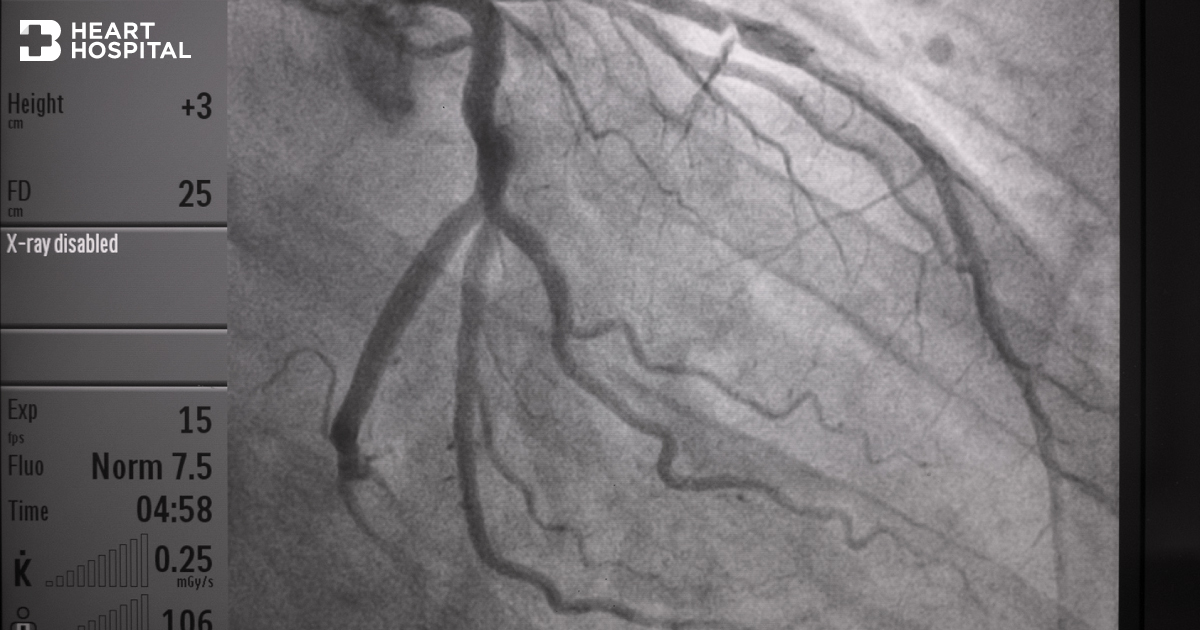Coronary Angiogram

diagnosis
table of contents
Coronary artery disease
Why do I need this test?
Indication
Risks
Preparation
During the procedure
How long is the procedure?
After the procedure
Result and recommendation
Call your doctor's office if
Coronary angiogram at Bangkok Heart Hospital
Coronary angiogram images
Coronary artery disease
Coronary artery disease (CAD) is the narrowing of the coronary arteries (the blood vessels that supply oxygen and nutrients to the heart muscle), caused by a buildup of fatty material within the walls of the arteries. This process causes the inside of the arteries to become narrowed, limiting the supply of oxygen-rich blood to the heart muscle. To better understand how coronary artery disease affects the heart, a review of basic heart anatomy and function is helpful.
The heart is basically a pump. The heart is made up of specialized muscle tissue, called the myocardium. The heart’s primary function is to pump blood throughout the body, so that the body’s tissues can receive oxygen and nutrients. Like any pump, the heart requires fuel in order to work. The myocardium requires oxygen and nutrients, just like any other tissue in the body. The blood that passes through the heart’s chambers is only passing through on its trip to the rest of the body. This blood does not give oxygen and nutrients to the myocardium. The myocardium receives its oxygen and nutrients from the coronary arteries, which lie on the outside of the heart.

Why do I need this test?
A coronary angiogram is a special X-ray test. It’s done to find out if your coronary arteries are narrowed or blocked, where and by how much. An angiogram can help your doctor see if you need treatment such as angioplasty or stent, coronary artery bypass surgery (CABG) or medical therapy.
Indication
- Symptoms of coronary artery disease, such as chest pain (angina).
- Pain in your chest, jaw, neck or arm that can’t be explained by other tests
- New or increasing chest pain (unstable angina).
- Heart failure.
- Other blood vessel problems or a chest injury.
- A heart valve problem that requires surgery.
- You may also need an angiogram if you’re going to have surgery unrelated to your heart, but you’re at high risk of having a heart problem during that surgery.
Because there’s a small risk of complications, angiograms are usually done after noninvasive heart tests have been performed, such as an electrocardiogram, an echocardiogram or a stress test.
Risks
As with most procedures done on your heart and blood vessels, a coronary angiogram has some risks. Major complications are rare, though. Potential risks and complications include:
- Heart attack
- Stroke
- Injury to the catheterized artery
- Irregular heart rhythms (arrhythmias)
- Allergic reactions to the dye or medications used during the procedure
- Damage to your heart or artery
- Cardiac tamponade
- Kidney damage from dye
- Excessive bleeding
- Infection
- Bruise around the catheter insertion site of varying size.
- Radiation exposure from the X-rays
In some cases, coronary angiograms are performed on an emergency basis. More commonly, though, they’re scheduled in advance, giving you time to prepare.
Preparation
Angiograms are performed in the catheterization (cath) lab of a hospital
For scheduled outpatient:
Usually you go to the hospital the morning of the procedure. Your health care team will give you specific instructions and talk to you about any medications you take.
- If the angiogram is scheduled in the morning, don’t eat or drink anything after midnight the day before your angiogram. Take all your medications to the hospital with you in their original bottles. Ask your doctor about whether or not to take your usual morning medications. If you have diabetes, ask your doctor if you should take insulin or other oral medications before your angiogram.
- For other time of the day schedule or non-elective case, your healthcare team will give the direction.
- Your doctor should know if you are allergic to seafood, or if you have had a bad reaction to contrast material in the past.
During the procedure
- Patient lies on your back on an X-ray table. Safety straps may be fastened across your chest and legs.
- X-ray cameras may move over and around your head and chest to take pictures from many angles.
- An intravenous (IV) line is inserted into a vein in your arm, if it has not been done before.
- You may be given a sedative through the IV to help you relax.
- You’ll be awake during the procedure so that you can follow instructions.
- You may be asked to take deep breaths, hold your breath, cough or place your arms in various positions.
- Electrodes on your chest monitor your heart throughout the procedure. A blood pressure cuff tracks your blood pressure, a pulse oximeter, measures the amount of oxygen in your blood.
- You may receive medication (anticoagulants) to help prevent your blood from clotting on the catheter and in your coronary arteries.
- A small amount of hair may be shaved from your groin or arm where the catheter is to be inserted. The area is washed and disinfected and then numbed with an injection of local anesthetic.
- A tiny cut is made at the entry site, and a short plastic tube (sheath) is inserted into your artery. The catheter is inserted through the sheath into your blood vessel and carefully threaded to your heart or coronary arteries.
- Threading the catheter shouldn’t cause pain. Tell your health care team if you have any discomfort.
- Dye (contrast material) is injected through the catheter. When this happens, you may have a brief sensation of flushing or warmth.
- The dye is easy to see on X-ray images, and as it moves through your blood vessels, your doctor can observe its flow and identify any blockages or constricted areas.
- Depending on what your doctor discovers during your angiogram, you may have additional catheter procedures at the same time, such as a balloon angioplasty or a stent placement to open up a narrowed artery.
- Patient lies on your back on an X-ray table. Safety straps may be fastened across your chest and legs.
- X-ray cameras may move over and around your head and chest to take pictures from many angles.
- An intravenous (IV) line is inserted into a vein in your arm, if it has not been done before.
- You may be given a sedative through the IV to help you relax.
- You’ll be awake during the procedure so that you can follow instructions.
- You may be asked to take deep breaths, hold your breath, cough or place your arms in various positions.
- Electrodes on your chest monitor your heart throughout the procedure. A blood pressure cuff tracks your blood pressure, a pulse oximeter, measures the amount of oxygen in your blood.
- You may receive medication (anticoagulants) to help prevent your blood from clotting on the catheter and in your coronary arteries.
- A small amount of hair may be shaved from your groin or arm where the catheter is to be inserted. The area is washed and disinfected and then numbed with an injection of local anesthetic.
- A tiny cut is made at the entry site, and a short plastic tube (sheath) is inserted into your artery. The catheter is inserted through the sheath into your blood vessel and carefully threaded to your heart or coronary arteries.
- Threading the catheter shouldn’t cause pain. Tell your health care team if you have any discomfort.
- Dye (contrast material) is injected through the catheter. When this happens, you may have a brief sensation of flushing or warmth.
- The dye is easy to see on X-ray images, and as it moves through your blood vessels, your doctor can observe its flow and identify any blockages or constricted areas.
- Depending on what your doctor discovers during your angiogram, you may have additional catheter procedures at the same time, such as a balloon angioplasty or a stent placement to open up a narrowed artery.
How long is the procedure?
Having an angiogram takes about one hour or less, although it may be longer, especially if combined with other heart catheter procedures. Preparation and post-procedure care can add more time.
After the procedure
- When the angiogram is over, the catheter is removed from your arm or groin followed by firm pressure application at the catheter insertion site to prevent bleeding for about 15 minutes.
- You’ll be taken to a recovery area for observation and monitoring. When your condition is stable, you return to your own room, where you’re monitored regularly. You’ll need to lie flat for several hours to avoid bleeding with the groin approach but not with the arm (wrist) approach. During this time, pressure may be applied to the incision to prevent bleeding and promote healing.
- You may be able to go home the same day, or you may have to remain in the hospital for a day or longer. (Depend on each hospital protocol).
- Drink plenty of fluids to help flush the dye from your body. You may start eating.
- Ask your health care team when you should resume taking your medications, bathe or shower, return to work, and resume other normal activities. Avoid strenuous activities and heavy lifting for several days. Your puncture site is likely to remain tender for a while. It may be slightly bruised and have a small bump.
Result and recommendation
An angiogram can show doctors what’s wrong with your blood vessels. It can:
- Show how many of your coronary arteries are blocked or narrowed by fatty plaques (atherosclerosis)
- Pinpoint where blockages are located in your blood vessels.
- Show how much blood flow is blocked through your blood vessels.
- Check the results of previous coronary bypass surgery.
- Check the blood flow through your heart and blood vessels.
- It’s also possible that angioplasty or stenting could be done during your angiogram to avoid needing another procedure (Angioplasty to help unblock clogged arteries).
Knowing this information can help your doctor determine what treatment is best for you and how much danger your heart condition poses to your health. Based on your results, your doctor may decide, for instance, that you would benefit from having coronary.
Call your doctor's office if
- You notice bleeding, new bruising or swelling at the catheter site
- You develop increasing pain or discomfort at the catheter site
- You have signs of infection, such as redness, drainage or fever
- There’s a change in temperature or color of the leg or arm that was used for the procedure
- You feel faint or weak.
- You develop chest pain or shortness of breath
- If the catheter site is actively bleeding or begins swelling, apply pressure to the site and contact emergency medical services.
Coronary angiogram at Bangkok Heart Hospital
- NCDR CathPCI participant
Coronary angiogram images



